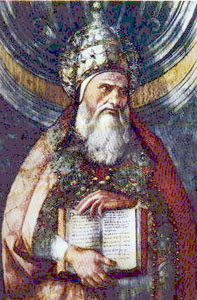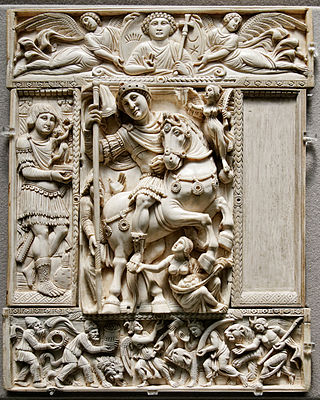Related Research Articles

Carthage was the capital city of ancient Carthage, on the eastern side of the Lake of Tunis in what is now Tunisia. Carthage was one of the most important trading hubs of the Ancient Mediterranean and one of the most affluent cities of the classical world.

Hannibal was a Carthaginian general and statesman who commanded the forces of Carthage in their battle against the Roman Republic during the Second Punic War. He is widely regarded as one of the greatest military commanders in history.

The Latin alphabet or Roman alphabet is the collection of letters originally used by the ancient Romans to write the Latin language. Largely unaltered with the exception of extensions, it forms the Latin script that is used to write English and other modern European languages. With modifications, it is also used for other alphabets, such as the Vietnamese alphabet. Its modern repertoire is standardised as the ISO basic Latin alphabet.

Pope Pius I was the bishop of Rome from c. 140 to his death c. 154, according to the Annuario Pontificio. His dates are listed as 142 or 146 to 157 or 161, respectively. He is considered to have opposed both the Valentinians and Gnostics during his papacy. He is considered a saint by the Catholic Church and the Eastern Orthodox Church with a feast day in 11 July, but it is unclear if he died as a martyr.
Pope Stephen I was the bishop of Rome from 12 May 254 to his death on 2 August 257. He was later canonized as a saint and some accounts say he was martyred while celebrating mass.

The Roman Empire was the post-Republican period of ancient Rome. As a polity, it included large territorial holdings around the Mediterranean Sea in Europe, North Africa, and Western Asia, and was ruled by emperors. From the accession of Caesar Augustus as the first Roman emperor to the military anarchy of the 3rd century, it was a Principate with Italia as the metropole of its provinces and the city of Rome as its sole capital. The Empire was later ruled by multiple emperors who shared control over the Western Roman Empire and the Eastern Roman Empire. The city of Rome remained the nominal capital of both parts until AD 476 when the imperial insignia were sent to Constantinople following the capture of the Western capital of Ravenna by the Germanic barbarians. The adoption of Christianity as the state church of the Roman Empire in AD 380 and the fall of the Western Roman Empire to Germanic kings conventionally marks the end of classical antiquity and the beginning of the Middle Ages. Because of these events, along with the gradual Hellenization of the Eastern Roman Empire, historians distinguish the medieval Roman Empire that remained in the Eastern provinces as the Byzantine Empire.

The Roman triumph was a civil ceremony and religious rite of ancient Rome, held to publicly celebrate and sanctify the success of a military commander who had led Roman forces to victory in the service of the state or, in some historical traditions, one who had successfully completed a foreign war.

The Crisis of the Third Century, also known as the Military Anarchy or the Imperial Crisis, was a period in which the Roman Empire nearly collapsed. The crisis ended due to the military victories of Aurelian and with the ascension of Diocletian and his implementation of reforms in 284.

The calendar of saints is the traditional Christian method of organizing a liturgical year by associating each day with one or more saints and referring to the day as the feast day or feast of said saint. The word "feast" in this context does not mean "a large meal, typically a celebratory one", but instead "an annual religious celebration, a day dedicated to a particular saint".

The Roman emperor was the ruler and monarchial head of state of the Roman Empire during the imperial period. The emperors used a variety of different titles throughout history. Often when a given Roman is described as becoming "emperor" in English it reflects his taking of the title augustus. Another title often used was caesar, used for heirs-apparent, and imperator, originally a military honorific. Early emperors also used the title princeps civitatis. Emperors frequently amassed republican titles, notably princeps senatus, consul, and pontifex maximus.

The Western Roman Empire comprised the western provinces of the Roman Empire at any time during which they were administered by a separate independent Imperial court; in particular, this term is used in historiography to describe the period from 395 to 476, where there were separate coequal courts dividing the governance of the empire in the Western and the Eastern provinces, with a distinct imperial succession in the separate courts. The terms Western Roman Empire and Eastern Roman Empire were coined in modern times to describe political entities that were de facto independent; contemporary Romans did not consider the Empire to have been split into two empires but viewed it as a single polity governed by two imperial courts as an administrative expediency. The Western Roman Empire collapsed in 476, and the Western imperial court in Ravenna was formally dissolved by Justinian in 554. The Eastern imperial court survived until 1453.

In modern historiography, Ancient Rome refers to Roman civilisation from the founding of the Italian city of Rome in the 8th century BC to the collapse of the Western Roman Empire in the 5th century AD. It encompasses the Roman Kingdom, Roman Republic and Roman Empire until the fall of the western empire.

Late antiquity is the time of transition from classical antiquity to the Middle Ages, generally spanning the 3rd–7th century in Europe and adjacent areas bordering the Mediterranean Basin. The popularization of this periodization in English has generally been credited to historian Peter Brown, after the publication of his seminal work The World of Late Antiquity (1971). Precise boundaries for the period are a continuing matter of debate, but Brown proposes a period between the 3rd and 8th centuries AD. Generally, it can be thought of as from the end of the Roman Empire's Crisis of the Third Century (235–284) to the early Muslim conquests (622–750), or as roughly contemporary with the Sasanian Empire (224–651). In the West its end was earlier, with the start of the Early Middle Ages typically placed in the 6th century, or earlier on the edges of the Western Roman Empire.

The fall of the Western Roman Empire was the loss of central political control in the Western Roman Empire, a process in which the Empire failed to enforce its rule, and its vast territory was divided into several successor polities. The Roman Empire lost the strengths that had allowed it to exercise effective control over its Western provinces; modern historians posit factors including the effectiveness and numbers of the army, the health and numbers of the Roman population, the strength of the economy, the competence of the emperors, the internal struggles for power, the religious changes of the period, and the efficiency of the civil administration. Increasing pressure from invading barbarians outside Roman culture also contributed greatly to the collapse. Climatic changes and both endemic and epidemic disease drove many of these immediate factors. The reasons for the collapse are major subjects of the historiography of the ancient world and they inform much modern discourse on state failure.

Dux is Latin for "leader" and later for duke and its variant forms. During the Roman Republic and for the first centuries of the Roman Empire, dux could refer to anyone who commanded troops, both Roman generals and foreign leaders, but was not a formal military rank.
Greece in the Roman era describes the Roman conquest of Greece, as well as the period of Greek history when Greece was dominated first by the Roman Republic and then by the Roman Empire.

The Holy Family consists of the Child Jesus, the Virgin Mary and Saint Joseph. The subject became popular in art from the 1490s on, but veneration of the Holy Family was formally begun in the 17th century by Saint François de Laval, the first bishop of New France, who founded a confraternity.
The Roman–Persian Wars, also known as the Roman–Iranian Wars, were a series of conflicts between states of the Greco-Roman world and two successive Iranian empires: the Parthian and the Sasanian. Battles between the Parthian Empire and the Roman Republic began in 54 BC; wars began under the late Republic, and continued through the Roman and Sasanian empires. A plethora of vassal kingdoms and allied nomadic nations in the form of buffer states and proxies also played a role. The wars were ended by the early Muslim conquests, which led to the fall of the Sasanian Empire and huge territorial losses for the Byzantine Empire, shortly after the end of the last war between them.

The Sasanian Empire, officially known as Eranshahr was the last Iranian empire before the early Muslim conquests of the 7th–8th centuries AD. Named after the House of Sasan, it endured for over four centuries, from 224 to 651 AD, making it the longest-lived Persian imperial dynasty. The Sasanian Empire succeeded the Parthian Empire, and re-established the Persians as a major power in late antiquity alongside its neighbouring arch-rival, the Roman Empire.
Rome's military was always tightly keyed to its political system. In the Roman Kingdom the social standing of a person impacted both his political and military roles, which were often organised into familial clans such as the Julia. These clans often wielded a large amount of power and were huge influences through the Roman Kingdom into the Roman Republic. The political system was from an early date based upon competition within the ruling elite, the patricians. Senators in the Republic competed fiercely for public office, the most coveted of which was the post of consul. Two consuls were elected each year to head the government of the state, and would be assigned a consular army and an area in which to campaign. From Gaius Marius and Sulla onwards, control of the army began to be tied into the political ambitions of individuals, leading to the First Triumvirate of the 1st century BC and the resulting Caesar's civil war. The late Republic and Empire was increasingly plagued by usurpations led by or supported by the military, leading to the Crisis of the third century in the late empire.